Operational Planning, Budgeting, Performance and Risk Assessment
VerifiedAdded on 2020/11/09
|21
|2416
|153
Report
AI Summary
This report delves into the core concepts of strategic and operational planning, emphasizing the role of operational plans in achieving organizational objectives. It outlines the key information typically included in an operational plan, such as objectives, resource allocation, timelines, and risk management strategies. The report also examines the purpose and process of budgeting, including its role in financial planning, control, and performance monitoring. It defines key performance indicators (KPIs) and explores various approaches to their development, along with the concept of a balanced scorecard as an alternative method for measuring business performance. Additionally, the report covers benchmarking as a tool for assessing business performance and provides definitions and responsibilities of a PCBU, and the aim and scope of the Fair Work Act 2009. Furthermore, the report includes a sample operational plan and risk management plan, along with detailed processes for staff recruitment, equipment purchasing, and a financial performance analysis including income budgets, expenses, and profit and loss summaries for two college campuses, highlighting variances and performance metrics.
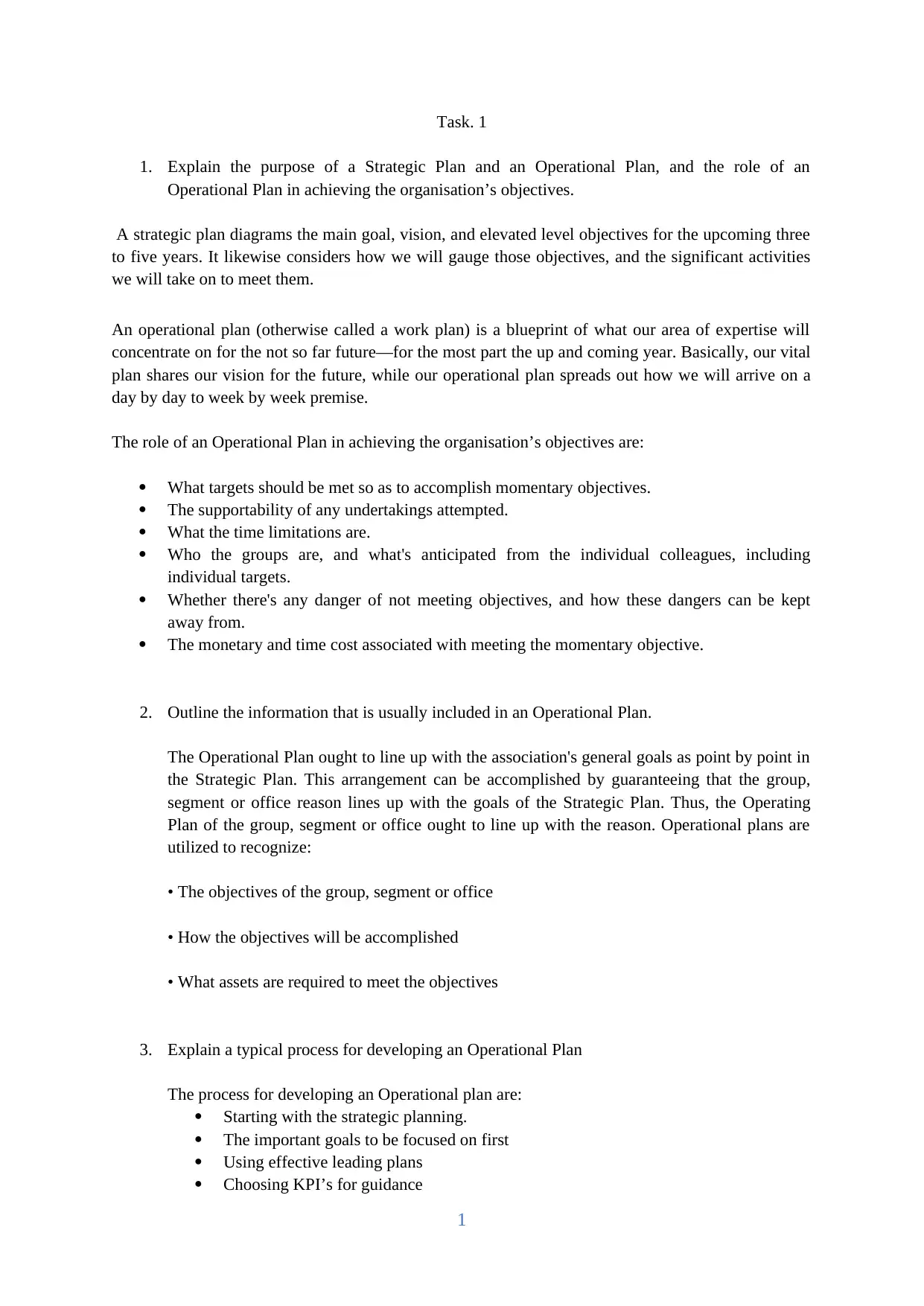
Task. 1
1. Explain the purpose of a Strategic Plan and an Operational Plan, and the role of an
Operational Plan in achieving the organisation’s objectives.
A strategic plan diagrams the main goal, vision, and elevated level objectives for the upcoming three
to five years. It likewise considers how we will gauge those objectives, and the significant activities
we will take on to meet them.
An operational plan (otherwise called a work plan) is a blueprint of what our area of expertise will
concentrate on for the not so far future—for the most part the up and coming year. Basically, our vital
plan shares our vision for the future, while our operational plan spreads out how we will arrive on a
day by day to week by week premise.
The role of an Operational Plan in achieving the organisation’s objectives are:
What targets should be met so as to accomplish momentary objectives.
The supportability of any undertakings attempted.
What the time limitations are.
Who the groups are, and what's anticipated from the individual colleagues, including
individual targets.
Whether there's any danger of not meeting objectives, and how these dangers can be kept
away from.
The monetary and time cost associated with meeting the momentary objective.
2. Outline the information that is usually included in an Operational Plan.
The Operational Plan ought to line up with the association's general goals as point by point in
the Strategic Plan. This arrangement can be accomplished by guaranteeing that the group,
segment or office reason lines up with the goals of the Strategic Plan. Thus, the Operating
Plan of the group, segment or office ought to line up with the reason. Operational plans are
utilized to recognize:
• The objectives of the group, segment or office
• How the objectives will be accomplished
• What assets are required to meet the objectives
3. Explain a typical process for developing an Operational Plan
The process for developing an Operational plan are:
Starting with the strategic planning.
The important goals to be focused on first
Using effective leading plans
Choosing KPI’s for guidance
1
1. Explain the purpose of a Strategic Plan and an Operational Plan, and the role of an
Operational Plan in achieving the organisation’s objectives.
A strategic plan diagrams the main goal, vision, and elevated level objectives for the upcoming three
to five years. It likewise considers how we will gauge those objectives, and the significant activities
we will take on to meet them.
An operational plan (otherwise called a work plan) is a blueprint of what our area of expertise will
concentrate on for the not so far future—for the most part the up and coming year. Basically, our vital
plan shares our vision for the future, while our operational plan spreads out how we will arrive on a
day by day to week by week premise.
The role of an Operational Plan in achieving the organisation’s objectives are:
What targets should be met so as to accomplish momentary objectives.
The supportability of any undertakings attempted.
What the time limitations are.
Who the groups are, and what's anticipated from the individual colleagues, including
individual targets.
Whether there's any danger of not meeting objectives, and how these dangers can be kept
away from.
The monetary and time cost associated with meeting the momentary objective.
2. Outline the information that is usually included in an Operational Plan.
The Operational Plan ought to line up with the association's general goals as point by point in
the Strategic Plan. This arrangement can be accomplished by guaranteeing that the group,
segment or office reason lines up with the goals of the Strategic Plan. Thus, the Operating
Plan of the group, segment or office ought to line up with the reason. Operational plans are
utilized to recognize:
• The objectives of the group, segment or office
• How the objectives will be accomplished
• What assets are required to meet the objectives
3. Explain a typical process for developing an Operational Plan
The process for developing an Operational plan are:
Starting with the strategic planning.
The important goals to be focused on first
Using effective leading plans
Choosing KPI’s for guidance
1
Paraphrase This Document
Need a fresh take? Get an instant paraphrase of this document with our AI Paraphraser
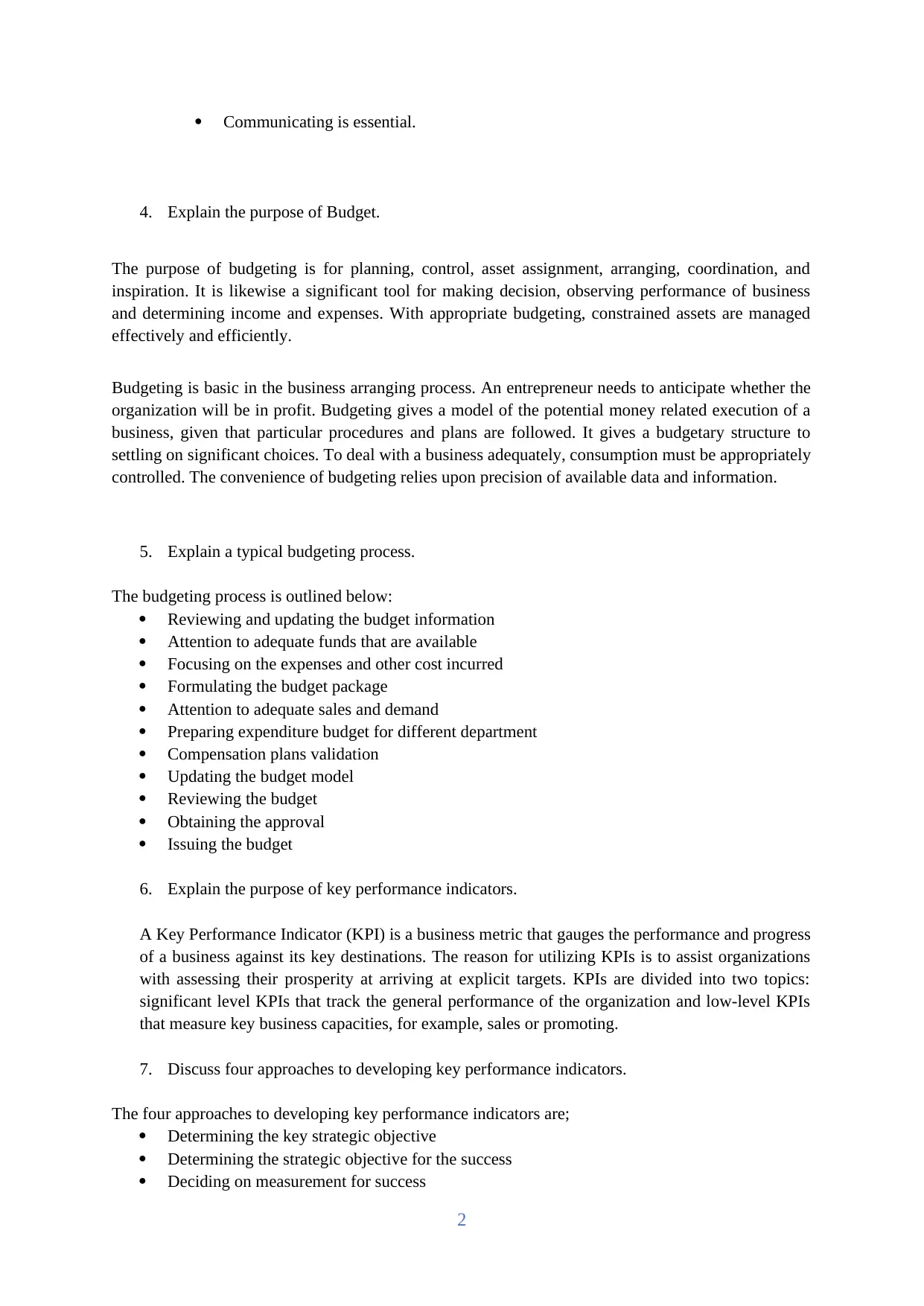
Communicating is essential.
4. Explain the purpose of Budget.
The purpose of budgeting is for planning, control, asset assignment, arranging, coordination, and
inspiration. It is likewise a significant tool for making decision, observing performance of business
and determining income and expenses. With appropriate budgeting, constrained assets are managed
effectively and efficiently.
Budgeting is basic in the business arranging process. An entrepreneur needs to anticipate whether the
organization will be in profit. Budgeting gives a model of the potential money related execution of a
business, given that particular procedures and plans are followed. It gives a budgetary structure to
settling on significant choices. To deal with a business adequately, consumption must be appropriately
controlled. The convenience of budgeting relies upon precision of available data and information.
5. Explain a typical budgeting process.
The budgeting process is outlined below:
Reviewing and updating the budget information
Attention to adequate funds that are available
Focusing on the expenses and other cost incurred
Formulating the budget package
Attention to adequate sales and demand
Preparing expenditure budget for different department
Compensation plans validation
Updating the budget model
Reviewing the budget
Obtaining the approval
Issuing the budget
6. Explain the purpose of key performance indicators.
A Key Performance Indicator (KPI) is a business metric that gauges the performance and progress
of a business against its key destinations. The reason for utilizing KPIs is to assist organizations
with assessing their prosperity at arriving at explicit targets. KPIs are divided into two topics:
significant level KPIs that track the general performance of the organization and low-level KPIs
that measure key business capacities, for example, sales or promoting.
7. Discuss four approaches to developing key performance indicators.
The four approaches to developing key performance indicators are;
Determining the key strategic objective
Determining the strategic objective for the success
Deciding on measurement for success
2
4. Explain the purpose of Budget.
The purpose of budgeting is for planning, control, asset assignment, arranging, coordination, and
inspiration. It is likewise a significant tool for making decision, observing performance of business
and determining income and expenses. With appropriate budgeting, constrained assets are managed
effectively and efficiently.
Budgeting is basic in the business arranging process. An entrepreneur needs to anticipate whether the
organization will be in profit. Budgeting gives a model of the potential money related execution of a
business, given that particular procedures and plans are followed. It gives a budgetary structure to
settling on significant choices. To deal with a business adequately, consumption must be appropriately
controlled. The convenience of budgeting relies upon precision of available data and information.
5. Explain a typical budgeting process.
The budgeting process is outlined below:
Reviewing and updating the budget information
Attention to adequate funds that are available
Focusing on the expenses and other cost incurred
Formulating the budget package
Attention to adequate sales and demand
Preparing expenditure budget for different department
Compensation plans validation
Updating the budget model
Reviewing the budget
Obtaining the approval
Issuing the budget
6. Explain the purpose of key performance indicators.
A Key Performance Indicator (KPI) is a business metric that gauges the performance and progress
of a business against its key destinations. The reason for utilizing KPIs is to assist organizations
with assessing their prosperity at arriving at explicit targets. KPIs are divided into two topics:
significant level KPIs that track the general performance of the organization and low-level KPIs
that measure key business capacities, for example, sales or promoting.
7. Discuss four approaches to developing key performance indicators.
The four approaches to developing key performance indicators are;
Determining the key strategic objective
Determining the strategic objective for the success
Deciding on measurement for success
2
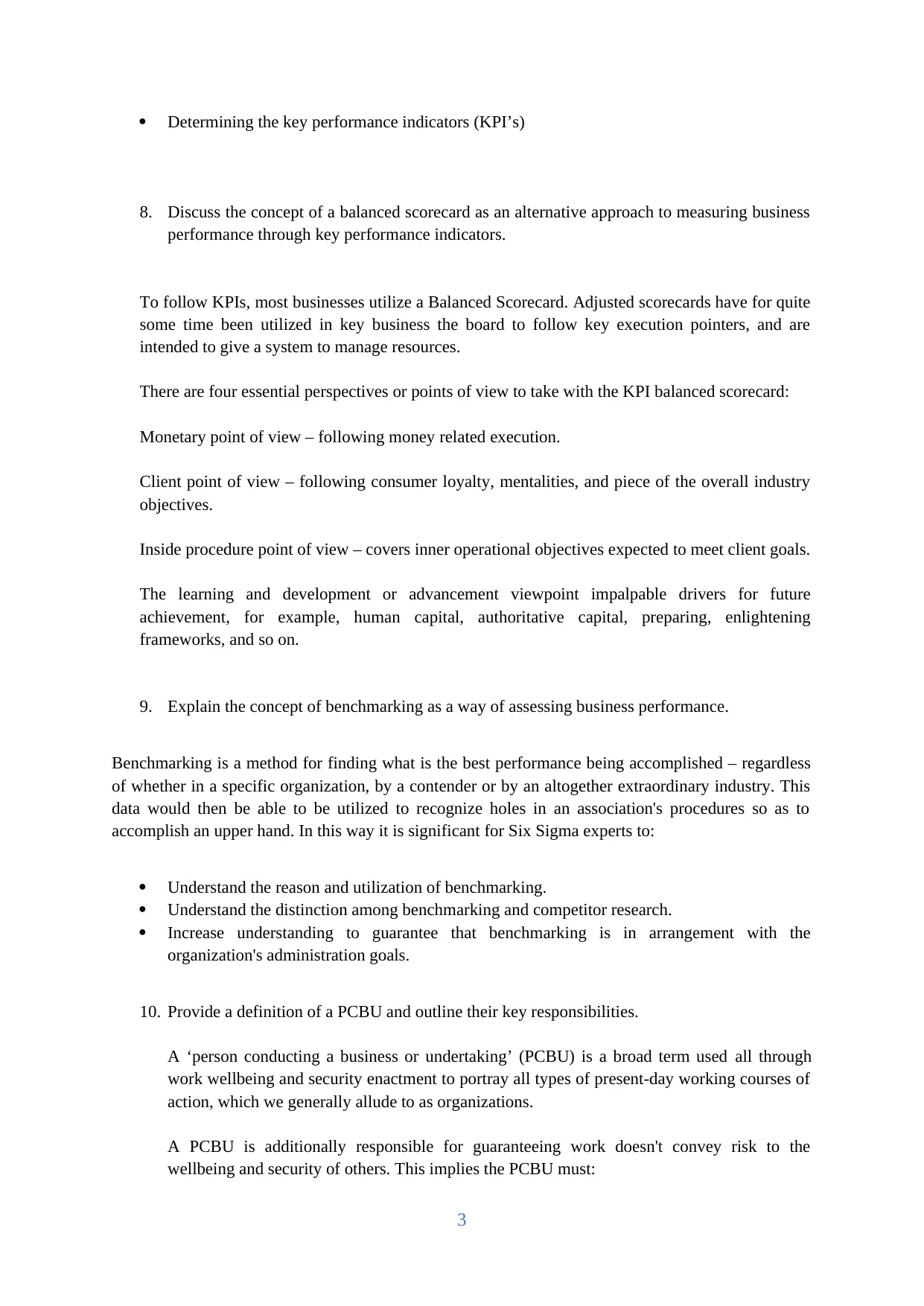
Determining the key performance indicators (KPI’s)
8. Discuss the concept of a balanced scorecard as an alternative approach to measuring business
performance through key performance indicators.
To follow KPIs, most businesses utilize a Balanced Scorecard. Adjusted scorecards have for quite
some time been utilized in key business the board to follow key execution pointers, and are
intended to give a system to manage resources.
There are four essential perspectives or points of view to take with the KPI balanced scorecard:
Monetary point of view – following money related execution.
Client point of view – following consumer loyalty, mentalities, and piece of the overall industry
objectives.
Inside procedure point of view – covers inner operational objectives expected to meet client goals.
The learning and development or advancement viewpoint impalpable drivers for future
achievement, for example, human capital, authoritative capital, preparing, enlightening
frameworks, and so on.
9. Explain the concept of benchmarking as a way of assessing business performance.
Benchmarking is a method for finding what is the best performance being accomplished – regardless
of whether in a specific organization, by a contender or by an altogether extraordinary industry. This
data would then be able to be utilized to recognize holes in an association's procedures so as to
accomplish an upper hand. In this way it is significant for Six Sigma experts to:
Understand the reason and utilization of benchmarking.
Understand the distinction among benchmarking and competitor research.
Increase understanding to guarantee that benchmarking is in arrangement with the
organization's administration goals.
10. Provide a definition of a PCBU and outline their key responsibilities.
A ‘person conducting a business or undertaking’ (PCBU) is a broad term used all through
work wellbeing and security enactment to portray all types of present-day working courses of
action, which we generally allude to as organizations.
A PCBU is additionally responsible for guaranteeing work doesn't convey risk to the
wellbeing and security of others. This implies the PCBU must:
3
8. Discuss the concept of a balanced scorecard as an alternative approach to measuring business
performance through key performance indicators.
To follow KPIs, most businesses utilize a Balanced Scorecard. Adjusted scorecards have for quite
some time been utilized in key business the board to follow key execution pointers, and are
intended to give a system to manage resources.
There are four essential perspectives or points of view to take with the KPI balanced scorecard:
Monetary point of view – following money related execution.
Client point of view – following consumer loyalty, mentalities, and piece of the overall industry
objectives.
Inside procedure point of view – covers inner operational objectives expected to meet client goals.
The learning and development or advancement viewpoint impalpable drivers for future
achievement, for example, human capital, authoritative capital, preparing, enlightening
frameworks, and so on.
9. Explain the concept of benchmarking as a way of assessing business performance.
Benchmarking is a method for finding what is the best performance being accomplished – regardless
of whether in a specific organization, by a contender or by an altogether extraordinary industry. This
data would then be able to be utilized to recognize holes in an association's procedures so as to
accomplish an upper hand. In this way it is significant for Six Sigma experts to:
Understand the reason and utilization of benchmarking.
Understand the distinction among benchmarking and competitor research.
Increase understanding to guarantee that benchmarking is in arrangement with the
organization's administration goals.
10. Provide a definition of a PCBU and outline their key responsibilities.
A ‘person conducting a business or undertaking’ (PCBU) is a broad term used all through
work wellbeing and security enactment to portray all types of present-day working courses of
action, which we generally allude to as organizations.
A PCBU is additionally responsible for guaranteeing work doesn't convey risk to the
wellbeing and security of others. This implies the PCBU must:
3
⊘ This is a preview!⊘
Do you want full access?
Subscribe today to unlock all pages.

Trusted by 1+ million students worldwide
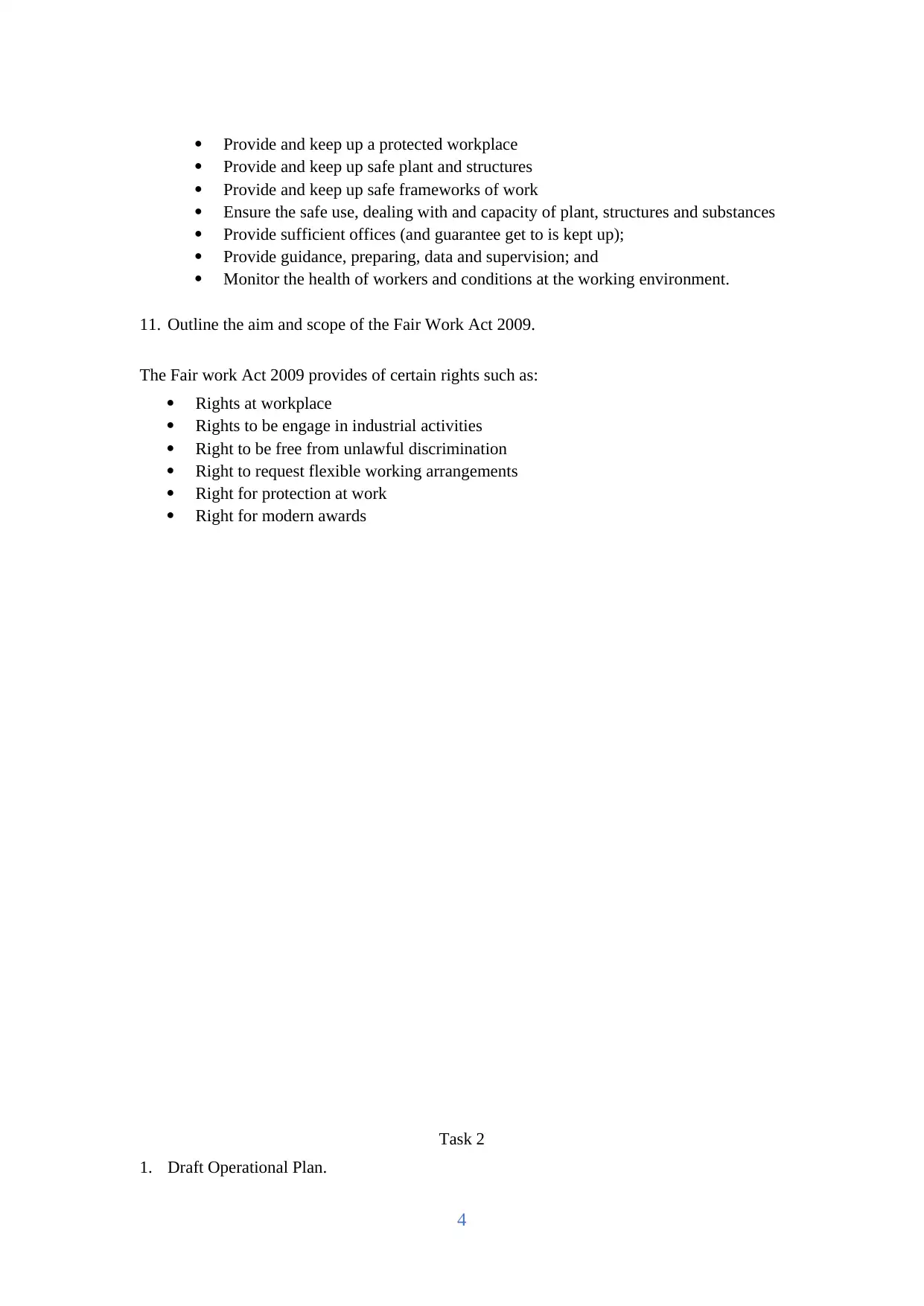
Provide and keep up a protected workplace
Provide and keep up safe plant and structures
Provide and keep up safe frameworks of work
Ensure the safe use, dealing with and capacity of plant, structures and substances
Provide sufficient offices (and guarantee get to is kept up);
Provide guidance, preparing, data and supervision; and
Monitor the health of workers and conditions at the working environment.
11. Outline the aim and scope of the Fair Work Act 2009.
The Fair work Act 2009 provides of certain rights such as:
Rights at workplace
Rights to be engage in industrial activities
Right to be free from unlawful discrimination
Right to request flexible working arrangements
Right for protection at work
Right for modern awards
Task 2
1. Draft Operational Plan.
4
Provide and keep up safe plant and structures
Provide and keep up safe frameworks of work
Ensure the safe use, dealing with and capacity of plant, structures and substances
Provide sufficient offices (and guarantee get to is kept up);
Provide guidance, preparing, data and supervision; and
Monitor the health of workers and conditions at the working environment.
11. Outline the aim and scope of the Fair Work Act 2009.
The Fair work Act 2009 provides of certain rights such as:
Rights at workplace
Rights to be engage in industrial activities
Right to be free from unlawful discrimination
Right to request flexible working arrangements
Right for protection at work
Right for modern awards
Task 2
1. Draft Operational Plan.
4
Paraphrase This Document
Need a fresh take? Get an instant paraphrase of this document with our AI Paraphraser
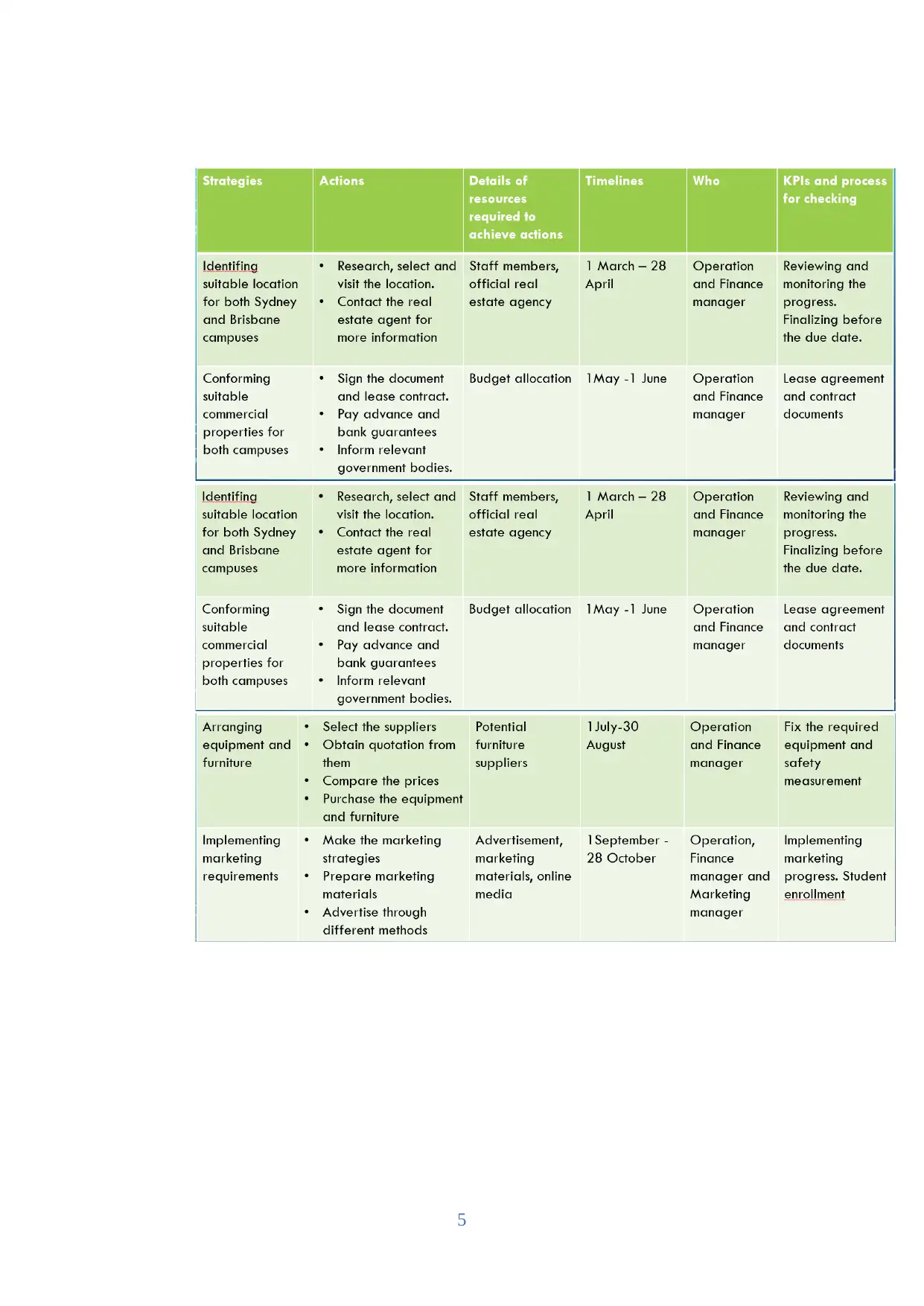
5
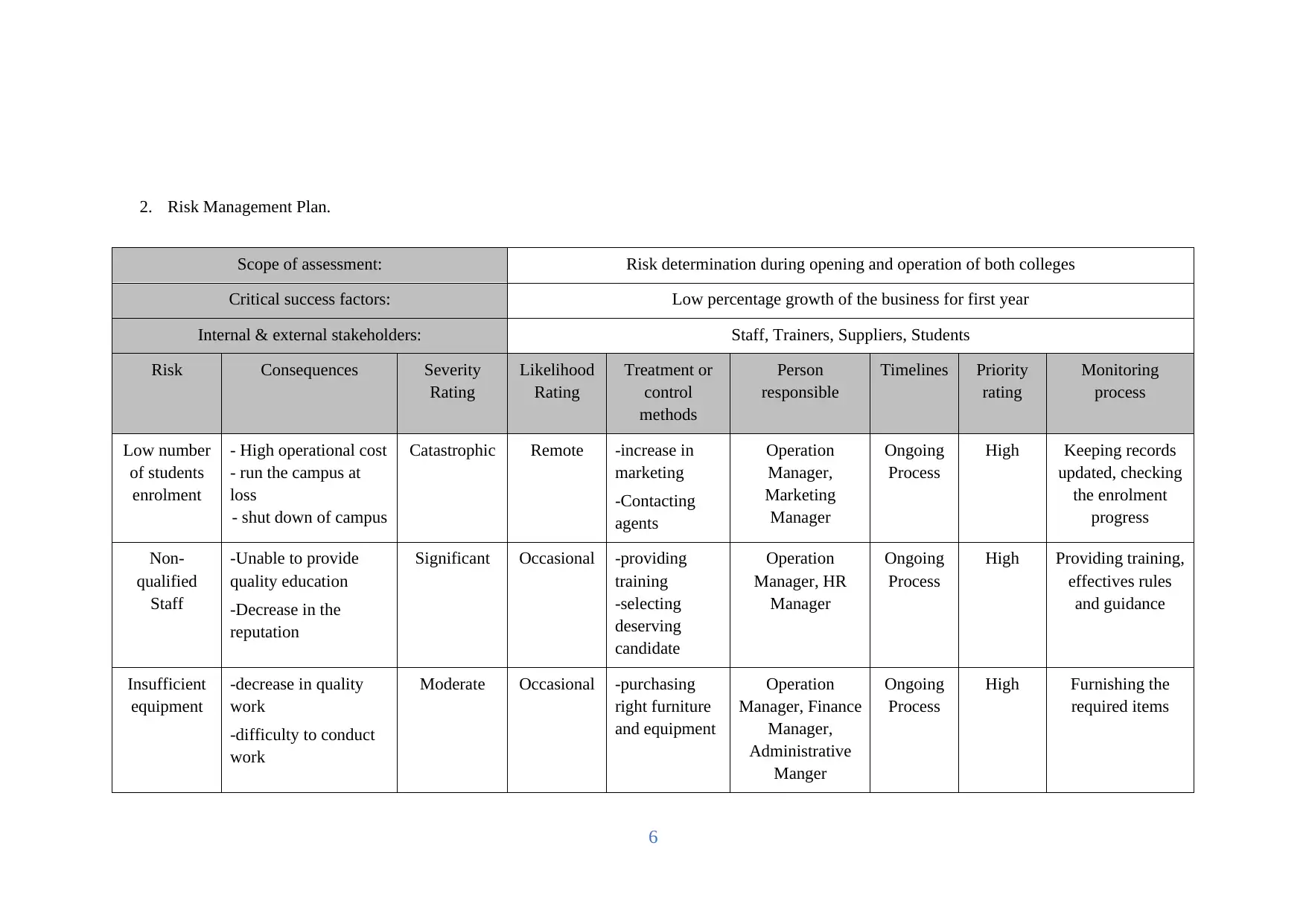
2. Risk Management Plan.
Scope of assessment: Risk determination during opening and operation of both colleges
Critical success factors: Low percentage growth of the business for first year
Internal & external stakeholders: Staff, Trainers, Suppliers, Students
Risk Consequences Severity
Rating
Likelihood
Rating
Treatment or
control
methods
Person
responsible
Timelines Priority
rating
Monitoring
process
Low number
of students
enrolment
- High operational cost
- run the campus at
loss
- shut down of campus
Catastrophic Remote -increase in
marketing
-Contacting
agents
Operation
Manager,
Marketing
Manager
Ongoing
Process
High Keeping records
updated, checking
the enrolment
progress
Non-
qualified
Staff
-Unable to provide
quality education
-Decrease in the
reputation
Significant Occasional -providing
training
-selecting
deserving
candidate
Operation
Manager, HR
Manager
Ongoing
Process
High Providing training,
effectives rules
and guidance
Insufficient
equipment
-decrease in quality
work
-difficulty to conduct
work
Moderate Occasional -purchasing
right furniture
and equipment
Operation
Manager, Finance
Manager,
Administrative
Manger
Ongoing
Process
High Furnishing the
required items
6
Scope of assessment: Risk determination during opening and operation of both colleges
Critical success factors: Low percentage growth of the business for first year
Internal & external stakeholders: Staff, Trainers, Suppliers, Students
Risk Consequences Severity
Rating
Likelihood
Rating
Treatment or
control
methods
Person
responsible
Timelines Priority
rating
Monitoring
process
Low number
of students
enrolment
- High operational cost
- run the campus at
loss
- shut down of campus
Catastrophic Remote -increase in
marketing
-Contacting
agents
Operation
Manager,
Marketing
Manager
Ongoing
Process
High Keeping records
updated, checking
the enrolment
progress
Non-
qualified
Staff
-Unable to provide
quality education
-Decrease in the
reputation
Significant Occasional -providing
training
-selecting
deserving
candidate
Operation
Manager, HR
Manager
Ongoing
Process
High Providing training,
effectives rules
and guidance
Insufficient
equipment
-decrease in quality
work
-difficulty to conduct
work
Moderate Occasional -purchasing
right furniture
and equipment
Operation
Manager, Finance
Manager,
Administrative
Manger
Ongoing
Process
High Furnishing the
required items
6
⊘ This is a preview!⊘
Do you want full access?
Subscribe today to unlock all pages.

Trusted by 1+ million students worldwide

7
Paraphrase This Document
Need a fresh take? Get an instant paraphrase of this document with our AI Paraphraser
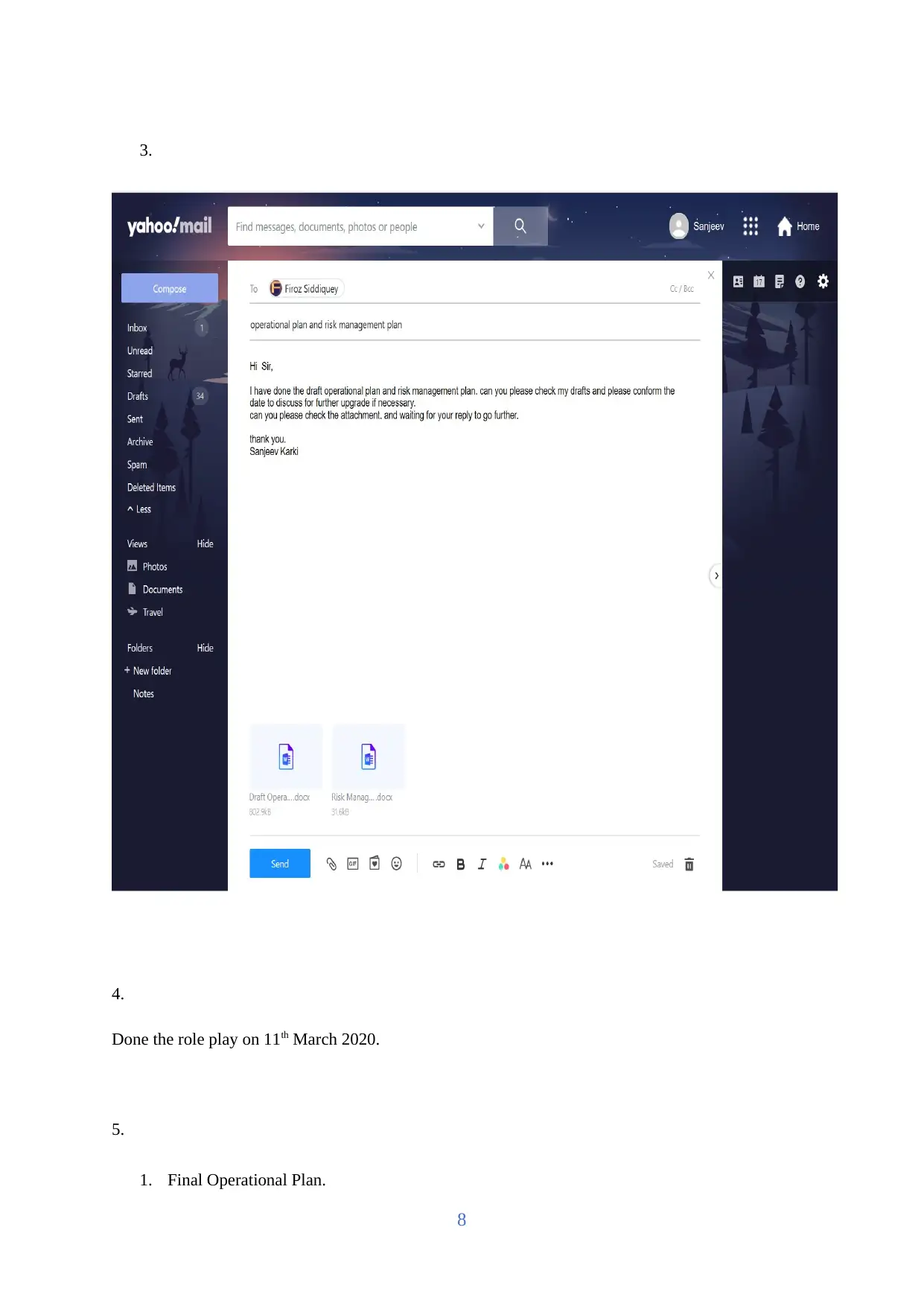
3.
4.
Done the role play on 11th March 2020.
5.
1. Final Operational Plan.
8
4.
Done the role play on 11th March 2020.
5.
1. Final Operational Plan.
8
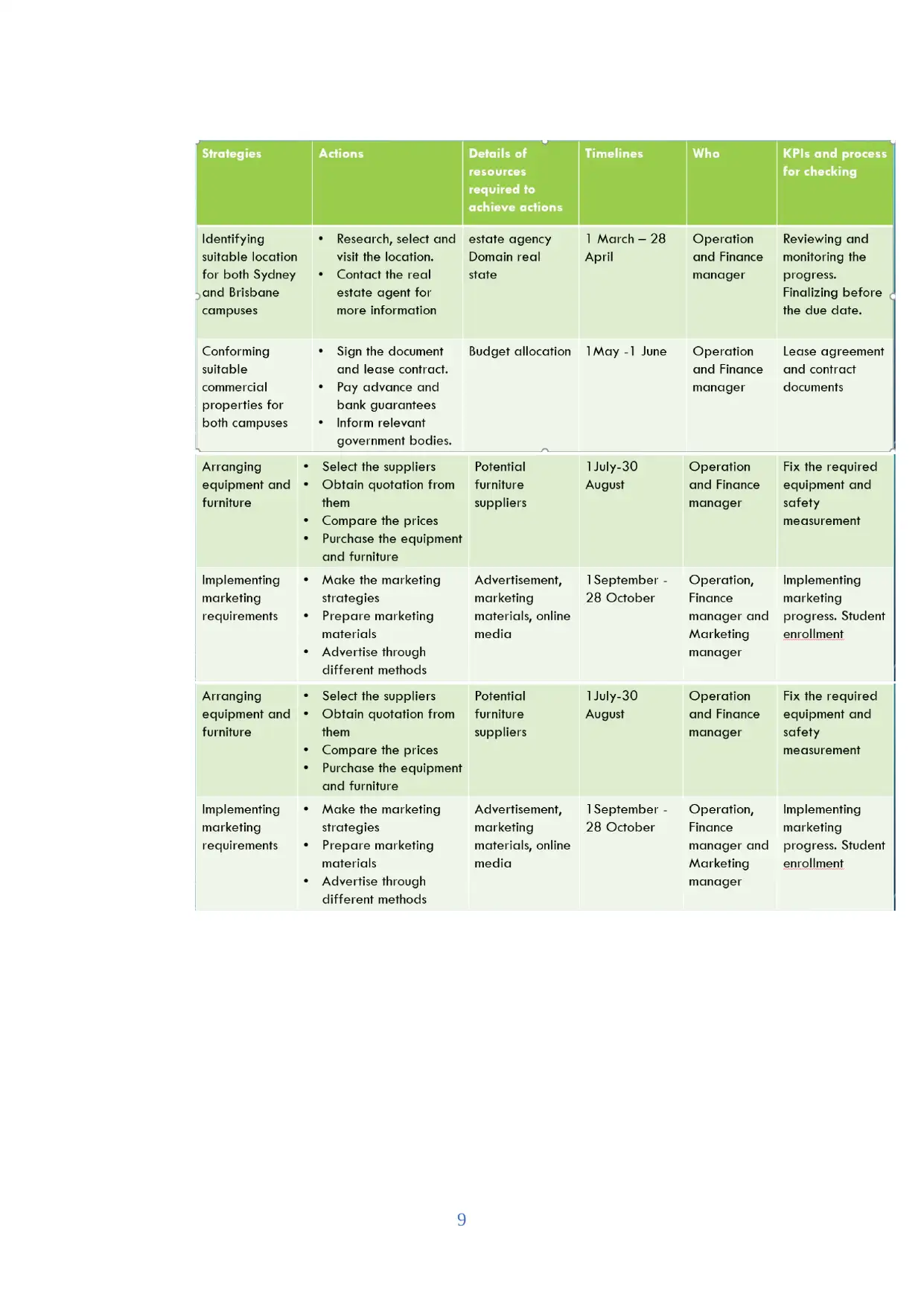
9
⊘ This is a preview!⊘
Do you want full access?
Subscribe today to unlock all pages.

Trusted by 1+ million students worldwide
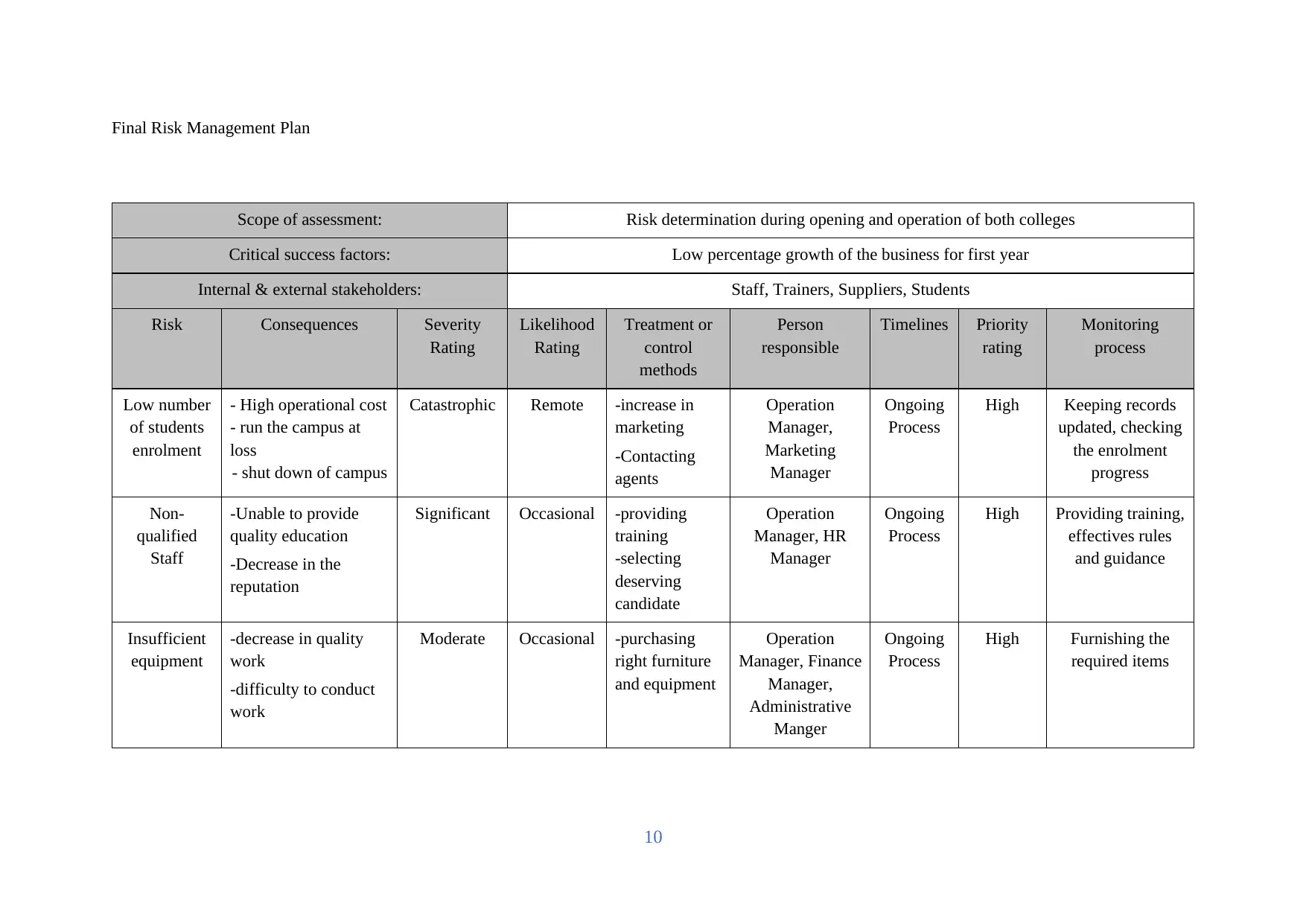
Final Risk Management Plan
Scope of assessment: Risk determination during opening and operation of both colleges
Critical success factors: Low percentage growth of the business for first year
Internal & external stakeholders: Staff, Trainers, Suppliers, Students
Risk Consequences Severity
Rating
Likelihood
Rating
Treatment or
control
methods
Person
responsible
Timelines Priority
rating
Monitoring
process
Low number
of students
enrolment
- High operational cost
- run the campus at
loss
- shut down of campus
Catastrophic Remote -increase in
marketing
-Contacting
agents
Operation
Manager,
Marketing
Manager
Ongoing
Process
High Keeping records
updated, checking
the enrolment
progress
Non-
qualified
Staff
-Unable to provide
quality education
-Decrease in the
reputation
Significant Occasional -providing
training
-selecting
deserving
candidate
Operation
Manager, HR
Manager
Ongoing
Process
High Providing training,
effectives rules
and guidance
Insufficient
equipment
-decrease in quality
work
-difficulty to conduct
work
Moderate Occasional -purchasing
right furniture
and equipment
Operation
Manager, Finance
Manager,
Administrative
Manger
Ongoing
Process
High Furnishing the
required items
10
Scope of assessment: Risk determination during opening and operation of both colleges
Critical success factors: Low percentage growth of the business for first year
Internal & external stakeholders: Staff, Trainers, Suppliers, Students
Risk Consequences Severity
Rating
Likelihood
Rating
Treatment or
control
methods
Person
responsible
Timelines Priority
rating
Monitoring
process
Low number
of students
enrolment
- High operational cost
- run the campus at
loss
- shut down of campus
Catastrophic Remote -increase in
marketing
-Contacting
agents
Operation
Manager,
Marketing
Manager
Ongoing
Process
High Keeping records
updated, checking
the enrolment
progress
Non-
qualified
Staff
-Unable to provide
quality education
-Decrease in the
reputation
Significant Occasional -providing
training
-selecting
deserving
candidate
Operation
Manager, HR
Manager
Ongoing
Process
High Providing training,
effectives rules
and guidance
Insufficient
equipment
-decrease in quality
work
-difficulty to conduct
work
Moderate Occasional -purchasing
right furniture
and equipment
Operation
Manager, Finance
Manager,
Administrative
Manger
Ongoing
Process
High Furnishing the
required items
10
Paraphrase This Document
Need a fresh take? Get an instant paraphrase of this document with our AI Paraphraser

11
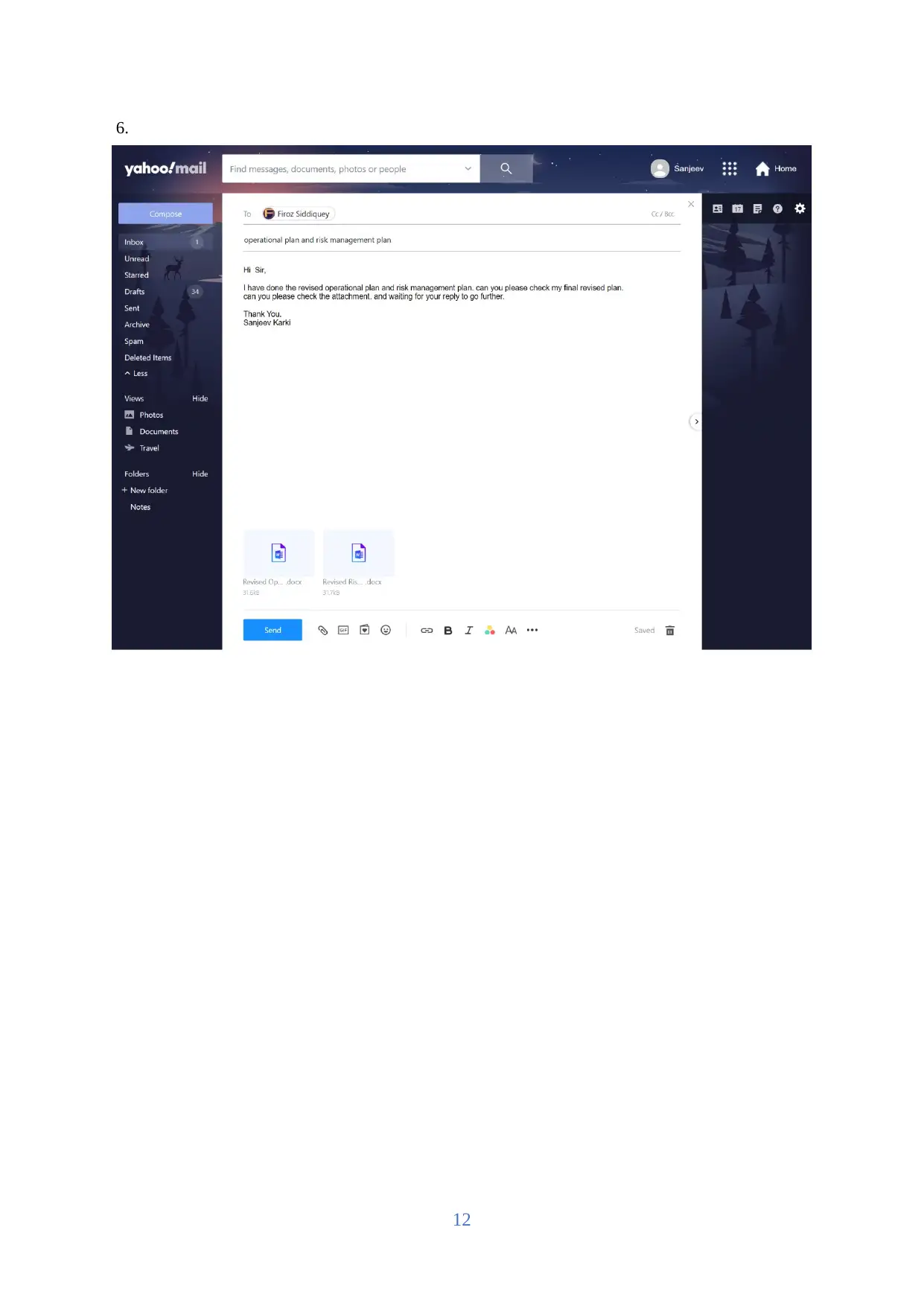
6.
12
12
⊘ This is a preview!⊘
Do you want full access?
Subscribe today to unlock all pages.

Trusted by 1+ million students worldwide
1 out of 21
Related Documents
Your All-in-One AI-Powered Toolkit for Academic Success.
+13062052269
info@desklib.com
Available 24*7 on WhatsApp / Email
![[object Object]](/_next/static/media/star-bottom.7253800d.svg)
Unlock your academic potential
Copyright © 2020–2025 A2Z Services. All Rights Reserved. Developed and managed by ZUCOL.



